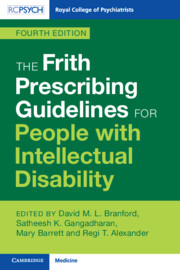Book contents
- The Frith Prescribing Guidelines for People with Intellectual Disability
- Reviews
- The Frith Prescribing Guidelines for People with Intellectual Disability
- Copyright page
- Contents
- Contributors
- Foreword
- Preface
- Acknowledgements
- Chapter 1 Intellectual Disability
- Chapter 2 Prescribing Practice
- Chapter 3 Physical Health Monitoring
- Chapter 4 Mental Health Conditions in People with Intellectual Disability
- Chapter 5 Trauma in People with Intellectual Disability
- Chapter 6 Anxiety Disorders
- Chapter 7 Depression
- Chapter 8 Bipolar Disorders
- Chapter 9 Schizophrenia
- Chapter 10 Aggression and Self-Injurious Behaviour
- Chapter 11 Personality Disorders
- Chapter 12 Sexual Offences and Paraphilias
- Chapter 13 Substance Use Disorders
- Chapter 14 Attention Deficit Hyperactivity Disorder
- Chapter 15 Autism
- Chapter 16 Sleep Disorders
- Chapter 17 Epilepsy
- Chapter 18 Dementia
- Chapter 19 Eating and Drinking Difficulties
- Chapter 20 Children and Adolescents
- Chapter 21 Prescribing for Health Issues in Women with Intellectual Disability
- Chapter 22 Older People
- Index
- References
Chapter 14 - Attention Deficit Hyperactivity Disorder
Published online by Cambridge University Press: 07 November 2024
- The Frith Prescribing Guidelines for People with Intellectual Disability
- Reviews
- The Frith Prescribing Guidelines for People with Intellectual Disability
- Copyright page
- Contents
- Contributors
- Foreword
- Preface
- Acknowledgements
- Chapter 1 Intellectual Disability
- Chapter 2 Prescribing Practice
- Chapter 3 Physical Health Monitoring
- Chapter 4 Mental Health Conditions in People with Intellectual Disability
- Chapter 5 Trauma in People with Intellectual Disability
- Chapter 6 Anxiety Disorders
- Chapter 7 Depression
- Chapter 8 Bipolar Disorders
- Chapter 9 Schizophrenia
- Chapter 10 Aggression and Self-Injurious Behaviour
- Chapter 11 Personality Disorders
- Chapter 12 Sexual Offences and Paraphilias
- Chapter 13 Substance Use Disorders
- Chapter 14 Attention Deficit Hyperactivity Disorder
- Chapter 15 Autism
- Chapter 16 Sleep Disorders
- Chapter 17 Epilepsy
- Chapter 18 Dementia
- Chapter 19 Eating and Drinking Difficulties
- Chapter 20 Children and Adolescents
- Chapter 21 Prescribing for Health Issues in Women with Intellectual Disability
- Chapter 22 Older People
- Index
- References
Summary
Attention Deficit Hyperactivity Disorder (ADHD) is a heterogeneous condition presenting with hyperactivity, impulsivity, and inattention that is pervasive. ADHD is a neurodevelopmental disorder with onset during childhood. Functional impairment can be manifested in academic, occupational, or social domains (American Psychiatric Association 2013; ICD-11 (11th revision) 2019). The degree of inattention and/or hyperactivity and impulsivity is beyond what is expected for the person’s age or level of intellectual abilities and can’t be explained by another mental disorder, The chapter presents an overview of the condition, including gender or other forms of variations in presentation, the many treatments with medication available, and its relevance.
Keywords
- Type
- Chapter
- Information
- Publisher: Cambridge University PressPrint publication year: 2024

